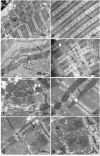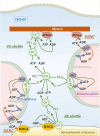Energetic Interactions Between Subcellular Organelles in Striated Muscles
- PMID: 33134298
- PMCID: PMC7561670
- DOI: 10.3389/fcell.2020.581045
Energetic Interactions Between Subcellular Organelles in Striated Muscles
Abstract
Adult striated muscle cells present highly organized structure with densely packed intracellular organelles and a very sparse cytosol accounting for only few percent of cell volume. These cells have a high and fluctuating energy demand that, in continuously working oxidative muscles, is fulfilled mainly by oxidative metabolism. ATP produced by mitochondria should be directed to the main energy consumers, ATPases of the excitation-contraction system; at the same time, ADP near ATPases should rapidly be eliminated. This is achieved by phosphotransfer kinases, the most important being creatine kinase (CK). Specific CK isoenzymes are located in mitochondria and in close proximity to ATPases, forming efficient energy shuttle between these structures. In addition to phosphotransfer kinases, ATP/ADP can be directly channeled between mitochondria co-localized with ATPases in a process called "direct adenine nucleotide channeling, DANC." This process is highly plastic so that inactivation of the CK system increases the participation of DANC to energy supply owing to the rearrangement of cell structure. The machinery for DANC is built during postnatal development in parallel with the increase in mitochondrial mass, organization, and complexification of the cell structure. Disorganization of cell architecture remodels the mitochondrial network and decreases the efficacy of DANC, showing that this process is intimately linked to cardiomyocyte structure. Accordingly, in heart failure, disorganization of the cell structure along with decrease in mitochondrial mass reduces the efficacy of DANC and together with alteration of the CK shuttle participates in energetic deficiency contributing to contractile failure.
Keywords: cardiac muscle; creatine kinase; energy metabolism; mitochondria; organelle interaction; sarcoplasmic reticulum; skeletal muscle cells.
Copyright © 2020 Piquereau, Veksler, Novotova and Ventura-Clapier.
Figures


Similar articles
-
Postnatal development of mouse heart: formation of energetic microdomains.J Physiol. 2010 Jul 1;588(Pt 13):2443-54. doi: 10.1113/jphysiol.2010.189670. Epub 2010 May 17. J Physiol. 2010. PMID: 20478976 Free PMC article.
-
Structural and functional adaptations of striated muscles to CK deficiency.Mol Cell Biochem. 2004 Jan-Feb;256-257(1-2):29-41. doi: 10.1023/b:mcbi.0000009857.69730.97. Mol Cell Biochem. 2004. PMID: 14977168 Review.
-
Functional coupling of creatine kinases in muscles: species and tissue specificity.Mol Cell Biochem. 1998 Jul;184(1-2):231-47. Mol Cell Biochem. 1998. PMID: 9746324
-
Energetic crosstalk between organelles: architectural integration of energy production and utilization.Circ Res. 2001 Jul 20;89(2):153-9. doi: 10.1161/hh1401.093440. Circ Res. 2001. PMID: 11463722
-
Architectural and functional remodeling of cardiac and skeletal muscle cells in mice lacking specific isoenzymes of creatine kinase.Gen Physiol Biophys. 2009 Sep;28(3):219-24. doi: 10.4149/gpb_2009_03_219. Gen Physiol Biophys. 2009. PMID: 20037186 Review.
Cited by
-
Metabolic Basis of Creatine in Health and Disease: A Bioinformatics-Assisted Review.Nutrients. 2021 Apr 9;13(4):1238. doi: 10.3390/nu13041238. Nutrients. 2021. PMID: 33918657 Free PMC article. Review.
-
VDAC2 as a novel target for heart failure: Ca2+ at the sarcomere, mitochondria and SR.Cell Calcium. 2022 Jun;104:102586. doi: 10.1016/j.ceca.2022.102586. Epub 2022 Mar 28. Cell Calcium. 2022. PMID: 35429733 Free PMC article. Review.
-
OMA1 High-Throughput Screen Reveals Protease Activation by Kinase Inhibitors.ACS Chem Biol. 2021 Nov 19;16(11):2202-2211. doi: 10.1021/acschembio.1c00350. Epub 2021 Oct 21. ACS Chem Biol. 2021. PMID: 34672515 Free PMC article.
-
Mitochondrial Calcium Overload Plays a Causal Role in Oxidative Stress in the Failing Heart.Biomolecules. 2023 Sep 19;13(9):1409. doi: 10.3390/biom13091409. Biomolecules. 2023. PMID: 37759809 Free PMC article. Review.
References
-
- Anmann T., Varikmaa M., Timohhina N., Tepp K., Shevchuk I., Chekulayev V., et al. (2014). Formation of highly organized intracellular structure and energy metabolism in cardiac muscle cells during postnatal development of rat heart. Biochim. Biophys. Acta 1837 1350–1361. 10.1016/j.bbabio.2014.03.015 - DOI - PubMed
Publication types
LinkOut - more resources
Full Text Sources
Research Materials

